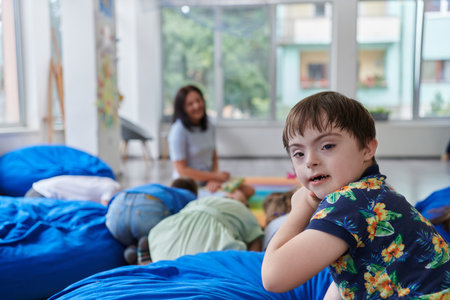1. Understanding Feng Shui for American Families
Feng Shui, an ancient Chinese practice, is all about creating spaces that promote balance, harmony, and well-being. For many American parents, these values align closely with the desire to provide a safe, nurturing, and positive environment for their children. When it comes to decorating your child’s room, Feng Shui offers practical guidance on how color choices can impact mood, sleep quality, and even learning abilities.
What Is Feng Shui?
At its core, Feng Shui is the art of arranging rooms and choosing elements—like colors and furniture placement—to support health and happiness. It is based on the idea that everything in our surroundings has energy, called “chi,” which can influence how we feel and function every day. In the context of American homes, Feng Shui isn’t about following strict traditions; it’s about using simple ideas to make family life smoother and more joyful.
Why Should Parents Care About Feng Shui?
American parents naturally want what’s best for their kids. Just as you might childproof your home or pick comfortable bedding, choosing the right colors for your child’s room can make a big difference. According to Feng Shui principles, certain colors help children feel calm and focused, while others might encourage creativity or restfulness. These ideas fit right in with modern parenting goals: supporting emotional wellness, healthy sleep habits, and a sense of security.
How Feng Shui Principles Connect with Everyday Parenting
| Feng Shui Principle | Everyday Parenting Example |
|---|---|
| Balance & Harmony | Creating routines that help kids feel secure |
| Positive Energy Flow (Chi) | Arranging furniture so kids have open space to play safely |
| Color Psychology | Selecting paint and decor that supports restful sleep or active learning |
| Simplicity & Clarity | Keeping rooms tidy to reduce stress for both parents and kids |
By understanding these basics, you’ll be ready to explore how specific colors can shape your child’s room in ways that reflect both Feng Shui wisdom and American family values.
2. Why Color Matters in a Child’s Room
Choosing the right colors for your child’s room goes beyond just making the space look nice. In both Feng Shui and modern child development, color is believed to have a real impact on how children feel, behave, and even learn. Understanding these effects can help parents in the US create a nurturing and supportive environment for their kids.
The Psychological and Emotional Effects of Color
Colors influence emotions, focus, energy levels, and overall mood. While every child is unique, research and ancient Feng Shui wisdom both suggest that certain colors tend to encourage specific feelings or reactions. Here’s a quick look at how some common room colors can affect children:
| Color | Feng Shui Meaning | Common Psychological Effect | Modern Parenting Tip |
|---|---|---|---|
| Blue | Calmness, wisdom | Reduces anxiety, encourages relaxation | Great for bedrooms or study areas to promote focus and restful sleep |
| Green | Growth, balance | Boosts concentration, relieves stress | Ideal for playrooms or spaces where creativity is encouraged |
| Yellow | Happiness, optimism | Energizes, uplifts mood | Use as an accent color; too much may overstimulate sensitive children |
| Pink | Nurturing, love | Soothes emotions, fosters compassion | A calming choice for young children’s rooms but best balanced with other tones as kids grow older |
| Purple | Inspiration, spirituality | Sparks imagination, creativity | Add in moderation for reading nooks or creative corners to avoid overwhelming the senses |
| White/Neutrals | Simplicity, clarity | Cleanses the mind, provides peace | A popular base in American homes—add pops of color for warmth and personality |
| Red/Orange | Passion, energy (use sparingly) | Stimulates activity, may increase excitement or restlessness | Best for small accents rather than main wall color; can be used in shared family spaces like playrooms for short bursts of energy |
Bridging Feng Shui Wisdom with Modern Parenting in the US
In Feng Shui practice, the flow of energy—or “Qi”—can be influenced by color choices. Similarly, US pediatricians and psychologists recognize that a child’s environment plays a big role in their well-being. By thoughtfully selecting colors based on both Feng Shui traditions and current psychological research, parents can support their child’s emotional health while also reflecting their family’s personal style.
A Simple Approach for Parents in the US
You don’t need to follow strict rules or trends to make your child’s room feel good. Start by noticing what colors your child naturally likes and which ones help them feel calm or happy. Think about the function of the room—should it be calming for bedtime or energizing for creative play? Combine this with Feng Shui tips and modern psychology to find a balance that works best for your family.
Remember: Every Child is Unique
No two children are exactly alike. Some may thrive surrounded by bright colors, while others feel most comfortable with soft pastels or neutral tones. Always involve your child in choosing their room colors when possible—this makes them feel included and helps ensure their space truly feels like home.

3. Popular Feng Shui Colors: Meanings and Uses
Choosing the right colors for your child’s room can be fun, especially when you use Feng Shui as a guide. Many popular Feng Shui colors not only bring positive energy but also fit well with common American children’s room themes. Let’s look at some of these colors, what they mean, and how they can match your child’s interests and current trends.
Common Feng Shui Colors for Kids’ Rooms
| Color | Feng Shui Meaning | Popular US Room Themes & Uses |
|---|---|---|
| Yellow | Cheerful, boosts learning and concentration | Perfect for playrooms or study areas; fits well with sunshine, nature, or animal-themed rooms |
| Light Blue | Calming, encourages communication and peace | Great for ocean or sky themes; popular in baby nurseries and shared bedrooms for siblings |
| Green | Growth, health, and balance | Blends with jungle, dinosaur, or botanical themes; ideal for nature-loving kids |
| Soft Pink | Love, comfort, and gentle energy | A classic choice for princess, unicorn, or fairy tale rooms; also used in modern minimalist spaces for a cozy touch |
| Cream/Off-White | Purity, openness, helps creativity flow | Makes small rooms feel bigger; great as a base color to mix with brighter accent colors and wall decals featuring favorite characters or sports teams |
| Peach/Coral | Warmth, friendliness, social energy | Adds a playful vibe to art corners or reading nooks; pairs well with beach or tropical themes popular in coastal states like California and Florida |
| Light Gray | Stability, calmness (when balanced) | A go-to neutral that works with superhero or space-themed decor; modern choice for older kids transitioning from childhood to teen years |
How to Use These Colors in American Children’s Rooms
- Accent Walls: Try painting one wall in a bold Feng Shui color while keeping the others neutral—this fits American trends of using feature walls.
- Themed Decor: Incorporate colors through bedding, rugs, curtains, or wall art that highlight your child’s favorite characters or hobbies.
- Flexible Accessories: Use colored bins, lampshades, and throw pillows so you can easily change the look as your child grows or their interests shift.
Tips for Parents in the US:
- If you share a room between siblings of different ages or genders, choose calming universal shades like soft blue or cream as the base.
- For energetic kids or play spaces, add pops of yellow or green to keep the mood upbeat but not overwhelming.
- If you want a trendy look that still follows Feng Shui principles, try light gray with colorful accents based on your child’s favorite sports team or cartoon.
Remember:
The best color is one that both supports your child’s wellbeing and feels personal to them. Let them help pick their favorites within these Feng Shui-friendly options for a happy, harmonious room!
4. How to Select the Best Colors for Your Child
When choosing Feng Shui colors for your child’s room, it’s important to consider both traditional color meanings and your child’s unique personality. In the United States, children are encouraged to express themselves and embrace their individuality, so blending Feng Shui wisdom with your family’s values makes the space feel personal and welcoming.
Understanding Your Child’s Energy and Preferences
Every child is different! Some kids are naturally energetic, while others may be calm or sensitive. Take time to observe your child’s moods and favorite activities. You can even ask them which colors they like best—letting them be part of the decision helps them feel at home in their own space.
Personality Types and Color Choices
| Personality Type | Feng Shui Color Suggestions | Why It Works |
|---|---|---|
| Active & Playful | Light Green, Soft Blue, Yellow | Green brings growth, blue calms energy, yellow adds cheerfulness without being overwhelming. |
| Quiet & Thoughtful | Pale Blue, Lavender, Cream | These colors promote relaxation and help create a peaceful environment for reading or quiet play. |
| Creative & Artistic | Peach, Light Purple, Aqua | Softer versions of these colors inspire imagination while keeping the room balanced and soothing. |
| Sensitive & Emotional | Soft Pink, Beige, Earthy Tones | Earth tones offer stability; gentle pink creates a sense of comfort and reassurance. |
Tips for Blending Feng Shui with US Cultural Values
- Celebrate Individuality: Let your child help pick accent pieces (like pillows or wall art) in their favorite colors—even if they’re not traditional Feng Shui shades.
- Diversity Matters: Mix and match patterns and textures from different cultures to reflect your family’s heritage or interests. For example, Native American-inspired prints or bold geometric shapes can be paired with calming wall colors.
- Stay Flexible: Use removable decals or posters so your child can update their room as they grow and change.
- Create Zones: If your child shares a room with a sibling, use rugs or curtains in their chosen colors to give each child a sense of ownership over their space.
Practical Steps for Parents
- Observe: Notice how your child reacts to different colors in stores or other homes.
- Select a Base Color: Choose a calming main color for walls based on your child’s needs and Feng Shui principles.
- Add Personality: Layer in accents through bedding, artwork, or furniture that reflect your child’s unique interests or background.
- Check Lighting: Test paint samples on the wall at different times of day—natural light changes how colors look!
- Involve Your Child: Make decorating a fun project you do together. This builds confidence and a stronger connection to their space.
The best children’s rooms combine harmony with creativity. By mixing Feng Shui guidance with American values of diversity and self-expression, you’ll create an environment where your child feels safe, inspired, and truly at home.
5. Blending Feng Shui with American Design Trends
Many parents want to create a children’s room that feels both harmonious and stylish. Blending Feng Shui color choices with popular American interior design trends is easier than you might think. Here are some practical ideas for integrating these two approaches in your home.
Mixing Feng Shui Colors with Popular US Styles
From modern farmhouse to boho chic, American homes celebrate a variety of design styles. You can choose Feng Shui-approved colors that work beautifully within these themes. Use the table below for inspiration:
| Design Style | Feng Shui Colors | Décor Ideas | Accessories Suggestions |
|---|---|---|---|
| Modern Farmhouse | Soft greens, light blues, creamy whites | Pale wood furniture, shiplap walls, woven baskets | Green plants, cotton throw pillows, simple wall art |
| Boho Chic | Earthy yellows, warm oranges, muted pinks | Patterned rugs, macramé hangings, rattan chairs | Crystal mobiles, woven lampshades, playful poufs |
| Minimalist | Neutral grays, soft whites, pale blues | Sleek shelves, low-profile beds, uncluttered surfaces | Simple bedding sets, subtle artwork, small potted plants |
| Coastal | Aqua blues, sandy beiges, seafoam greens | Nautical stripes, driftwood accents, airy curtains | Shell décor pieces, ocean-inspired prints, blue cushions |
| Traditional Americana | Pale reds (for energy), navy blues (for calm) | Classic quilts, wood dressers, vintage toys | Star motifs, flag patterns (in moderation), storybooks on display |
Adapting Traditional Feng Shui for Modern US Homes
You don’t need to follow every traditional Feng Shui rule exactly—especially in contemporary American spaces. Focus on these tips:
- Select Meaningful Colors: Pick shades that support your child’s needs—like soothing blues for better sleep or energetic yellows for creativity—and match them with your overall home style.
- Add Color Through Décor: If repainting isn’t an option or you’re renting your home, use colored bedding, rugs, curtains, or wall decals to bring in lucky hues.
- Avoid Overwhelm: Use bold colors as accents rather than on every wall. A few bright pillows or a colorful bookshelf can have just as much impact without overwhelming the space.
- Create Balance: Mix calming and energizing elements so the room supports both rest and play. For example, pair soft blue walls with orange artwork or green plants.
- Cherish Personal Touches: Display your child’s artwork or favorite items alongside Feng Shui-friendly pieces. This ensures their space feels special and personalized.
Practical Example: A Balanced Bedroom Makeover
If your child loves superheroes but you want to maintain good Feng Shui energy:
- Main Wall Color: Soft gray or blue (calm and focus)
- Bedding & Accessories: Red superhero pillowcases or posters (energy and courage)
- Drapes & Rug: White or beige tones (balance and stability)
- Add Plants: Small green plant near the window (growth and health)
- Shelf Decor: Mix superhero action figures with family photos for warmth and comfort
Your Child’s Room Can Be Both Stylish and Harmonious!
The key is to blend the best of both worlds: choose Feng Shui colors that support your child’s well-being while adapting them to fit the look and feel of your American home. With a little creativity and flexibility, you’ll create a welcoming space where your child can thrive.


